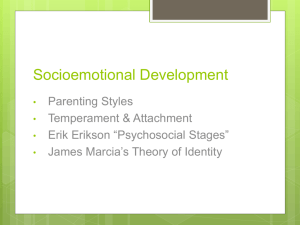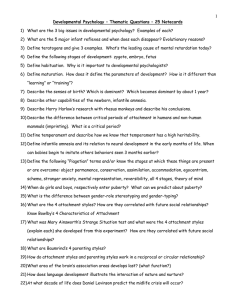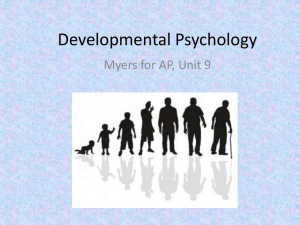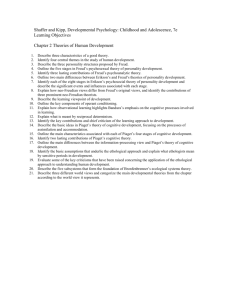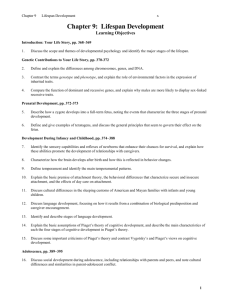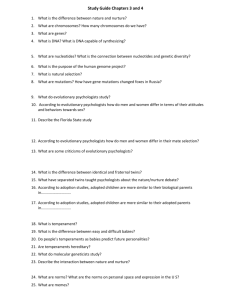Chapter 11
advertisement
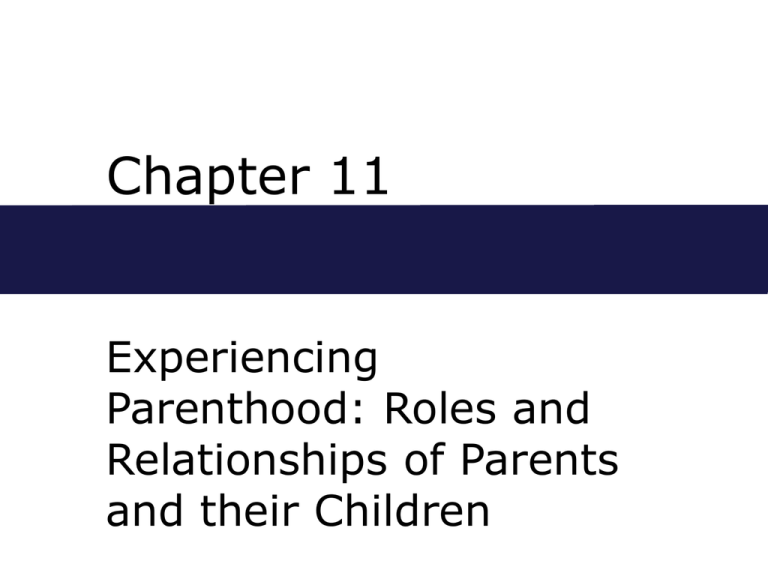
Chapter 11 Experiencing Parenthood: Roles and Relationships of Parents and their Children Chapter Outline Being Parents Who Actually Takes Care of the Children? Theories of Child Socialization From the Theoretical to the Practical: Expert Advice on Child Rearing Chapter Outline Styles and Strategies of Child Rearing Children’s Needs, Parents’ Needs Parents’ Needs Issues of Diverse Families Parenting and Caregiving in Later Life Two Extremes Among Contemporary Fathers: 1. 2. Many men aspire for active, meaningful involvement with their children Others, especially divorced fathers, maintain little actual contact with their children. Mental Child Care Worrying: – Mothers worry about their babies more than fathers do. – Baby worry refers to all the things that women as primary caregivers must concern themselves with. – Mother worry refers to whether one is being a good enough mother. Mental Child Care Processing information: – Mothers seek out additional information or advice about children’s development and needs. – Mothers spend more time and energy in seeking, finding, and disseminating than men do in receiving advice or information. Mental Child Care Managing the division of labor: – Women bear the brunt of having to seek assistance with child care from their partners. – They have to decide what type of help to ask for, when to seek it, and what to do if it is not forthcoming. Non Parental Child Care 77% of the more than 8 million 3- to 5year-olds are in some form of nonparental child care. 3 out of 4 children from families earning over $75,000, spend time in “centerbased programs”. Among children whose families earn less than $40,000, little more than half spend time in such programs. Freud, Piaget, and Erikson Compared Infancy Freud Piaget Erikson Oral Sensorimotor Trust vs. mistrust Autonomy vs. shame and doubt Anal Early childhood Phallic Preoperational Initiative vs. guilt Freud, Piaget, and Erikson Compared Freud Piaget Late-middle childhood Latency Concrete operational Adolescence Genital Formal operational Erikson Industry vs. inferiority Identity vs. confusion Freud, Piaget, and Erikson Compared Freud Piaget Erikson Early adulthood Intimacy vs. isolation Middle adulthood Generativity vs. stagnation Late adulthood Ego integrity vs. despair Attachment Patterns in 12- to 18-Month-Olds in the “Strange Situation” Attachment pattern Secure Anxious/ ambivalent Anxious/ avoidant Behavior Before Separation Separates from mother to explore toys; is friendly toward stranger when mother is there Has difficulty separating to explore toys; stays close to mother Separates to explore toys; shows little preference for parent over stranger Attachment Patterns in 12- to 18-Month-Olds in the “Strange Situation” Attachment Pattern Behavior During Separation Secure May cry; play is subdued for a while, usually recovers, plays Anxious/ ambivalent Is very distressed; cries hysterically, continues to cry; Anxious/ avoidant Shows no distress;continues to play; interacts with strangers Attachment Patterns in 12- to 18-Month-Olds in the “Strange Situation” Attachment Pattern Reunion Behavior Secure If distressed during separation, contact with mother ends distress; if not distressed; greets mother with affection Anxious/ ambivalent Seeks comfort but then rejects it; may be passive Anxious/ avoidant Ignores or moves away from mother. Attachment Patterns in 12- to 18-Month-Olds in the “Strange Situation” Attachment Pattern Behavior with Stranger Secure Somewhat friendly; may play with stranger Anxious/ ambivalent Wary of stranger; rejects offers to play Anxious/ avoidant Does not avoid staranger Needs for Optimal Child Development Adequate prenatal nutrition and care. Appropriate stimulation and care of newborns. The formation of at least one close attachment during the first five years. Needs for Optimal Child Development Support for the family including child care when a parent or parents must work. Protection from illness. Freedom from physical and sexual abuse. Supportive friends, both adults and children. Needs for Optimal Child Development Respect for the child’s individuality and appropriate challenges leading to competence. Safe, nurturing, and challenging schooling. An adolescence “free of pressure to grow up too fast, yet respectful of natural biological transformations” Protection from premature parenthood. % of Population, Over 30, Responsible for Grandchildren, 2000 Gay and Lesbian Parents Children of gay and lesbian generally: – Maintain close relationships with their parents. – Are well-adjusted. – Develop the same sexual orientations and gender roles as children of heterosexuals. Comtemporary Strategies for Child Rearing Include elements of: – Mutual respect – Consistency and clarity – Logical consequences – Open communication – Behavior modification in place of physical punishment. Grandparenting An important role for the middleaged and aged. Three Styles of Grandparenting: 1. Companionate 2. Remote 3. Involved

